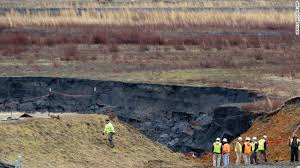By Ted Caddell
Duke Energy this month filed a plan with North Carolina environmental agencies to remove millions of tons of coal ash from four sites in the state, the beginning of a multi-year $3.4 billion remediation effort. Duke, which reported operating revenue of $26.4 billion last year, has not said how the cost will impact earnings.
Other coal-burning utilities may also be facing large cleanup bills as state and federal regulators increase their scrutiny following spills by Duke and the Tennessee Valley Authority.
So far, storage and disposal of coal ash and related materials is not federally regulated. That is expected to change on Dec. 19, when the Environmental Protection Agency is scheduled to announce a long-awaited rule.
The EPA proposed coal ash rules in 2010 but, under political pressure from industrial groups, the White House sent the rules back for rewriting. It took a court-ordered consent decree to set the Dec. 19 deadline.
Utilities are waiting to see whether the proposed rule, now at the White House for review, will classify coal ash as “hazardous,” which would require more strict remediation and disposal rules than classification as “special wastes.”
140 Million Tons Annually

Earthjustice, an environmental group that successfully argued in court for the December deadline, says in a report that there are 208 documented cases of contamination caused by coal ash spills. It says that coal-fired power plants generate about 140 million tons of coal-related ash and sludge a year, all of it containing toxic materials.
Public opinion turned against Duke after a pipe at an impound pond on the Dan River near Eden, N.C., failed, dumping 39,000 tons of coal ash sludge, containing toxins such as arsenic, boron, cadmium, lead and mercury, into the river.
The result was state legislation approved in August that could be a model for other state efforts. The North Carolina law, a compromise enacted during a special session, requires elimination of leaks at coal impounds but does not require removal. It left open the question of whether the cost of coal-ash remediation could be passed on to customers while setting up a Coal Ash Commission under the state Department of Public Safety.
Under the law, all basins at four of Duke’s sites — Asheville Steam Electric Plant, Dan River, Riverbend Steam Station and the L.V. Sutton Steam Electric Plant — must close by August 2019.
Duke’s remediation plan goes further. On Nov. 13, the company said it will permanently close the sites and excavate and move more than 5 tons of ash from them. It said it has 108 million tons in basins throughout North Carolina, 30 million tons in landfills and 14 million tons at its own plant sites. The company also said it is developing plans for the next phase while awaiting approval for the work at the first four sites.
“We think these excavation plans go beyond the specific information requested by the state, demonstrating our commitment to closing ash basins in a way that continues to protect the environment, minimizes the impact to neighboring communities and complies with North Carolina’s new coal-ash management policies,” said John Elnitsky, Duke’s senior vice president of ash-basin strategy. “We are prepared to proceed as soon as we have the necessary approvals from the state.”
TVA: $3.2 Billion
Duke is not the only utility confronting the coal ash issue.
The Tennessee Valley Authority this summer agreed to pay $27 million to settle claims from property owners who said they suffered damage from a 2008 spill of 5 million cubic yards of contaminated coal ash. The settlement came after a 2012 ruling from a U.S District Court judge that TVA violated its own policies. The failure of a storage pond dike at TVA’s Kingston Fossil Plant allowed tons of coal ash sludge to flow into the Emory and Clinch rivers, contaminating properties downstream.
TVA says it has spent $1.2 billion on cleanup so far and has committed to converting its wet ash storage to dry ash, at a cost of another $2 billion. The $27 million settlement is on top of about $80 million it spent to settle about 200 other Kingston-related claims. It also gave $43 million in economic-development grants in the area. That makes about $150 million in claims and grants and $3.2 billion in cleanup costs. TVA reported $11 billion in operating revenue in 2013.
It was the Kingston spill that spurred the EPA rulemaking.
Following Duke’s spill, other companies found themselves drawn into the spotlight. Two environmental groups filed suit against Louisville Gas & Electric for what they say is illegal dumping of coal ash into the Ohio River. LG&E said the treated water it releases into the river is within the limits of its state-issued discharge permits.
In a report issued last week, a Wisconsin environmental group said utilities could be contaminating drinking water by using coal ash for structural fill without first lining the deposit sites to prevent leaching in the state.
The organization, Clean Wisconsin, said the state allows such “beneficial reuse” and that up to 85% of coal ash generated in the state is reused.
“In Wisconsin, large coal plants alone generate nearly 1.8 million tons of toxic coal ash annually, of which 85% goes to ‘beneficial use’ projects. This includes dumping under churches and schools, under or atop roads, on park paths and more,” the report states. The group called for the state to adopt rules like North Carolina’s.

